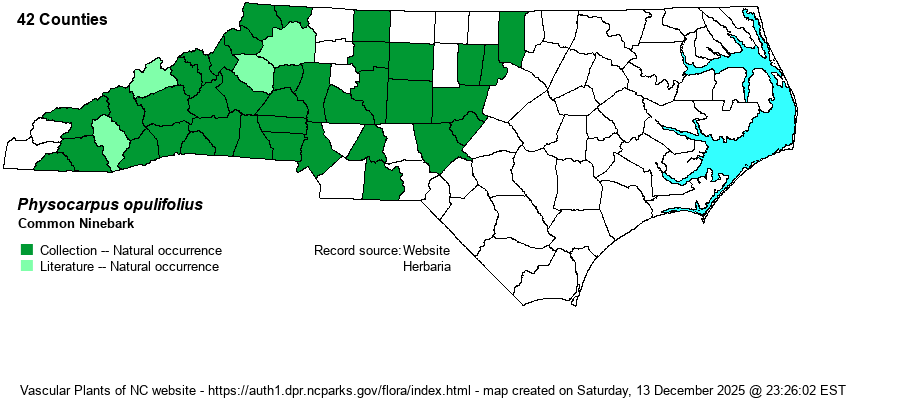| Author | (L.) Maximowicz | |
| Distribution | Throughout the Mountains and the western and central Piedmont, but rare to absent in the far northeastern Piedmont counties (such as from Wake and Vance eastward to the Fall Line). Present in the southeastern Piedmont counties, however. Absent from the Coastal Plain and Sandhills.
This shrub has a wide range, mainly north of NC. From Canada it ranges south mainly in the mountains and Piedmont to central AL and central AR, but there are records reaching into the FL panhandle.
| |
| Abundance | Frequent to common in much of the Mountains and western Piedmont. Uncommon to infrequent in the central Piedmont and rare in the eastern Piedmont. Seemingly absent east of Granville and Moore counties. | |
| Habitat | It has very diverse habitats, but it is mostly found on fairly high to high pH soils. It is most often seen along stream banks, even in somewhat open areas (such as through meadows), but it also occurs in bogs and wet thickets, as well as seepages and other damp spots on cliffs and exposed outcrops. The species favors sunny or partly open sites as opposed to shady sites. |
| Phenology | Blooms after leaves are fully grown, from May into July; fruits from July to September. | |
| Identification | This is a deciduous shrub growing from 3-10 feet tall, but as it has long and gracefully arching stems, it is often wider than tall. It also has shreddy bark that gives the species its common name. It has a distinctive inflorescence -– looking like a golf ball in flower; its small white flowers grow in a ball-like hemisphere. The leaves are widely ovate to triangular in shape, quite heavily toothed. As it is the only species in its genus in the eastern U.S., it really looks like nothing else in the region, at least when the inflorescence is seen. Biologists will be a bit surprised that such a widespread montane plant found along streams through pastures can have such a “picky” habitat along rocky streams and bluffs –- over mafic rocks -- in the Piedmont. | |
| Taxonomic Comments | Some old references placed the species in the genus Opulaster, with several other specific names; nearly all recent ones do place it in Physocarpus. Weakley (2018) gives two varieties of the species in the Southeast: the widespread opulifolius, and the poorly known intermedius (which has been found in the NC Piedmont but is rare).
| |
| Other Common Name(s) | Often named simply as “Ninebark” in the East. However, as there are about four other species in the genus in the West, a modifier is needed – e.g., Common Ninebark. Also known as Eastern Ninebark and Atlantic Ninebark. | |
| State Rank | S4 | |
| Global Rank | G5 | |
| State Status | | |
| US Status | | |
| USACE-agcp | FAC link |
| USACE-emp | FACW link |

